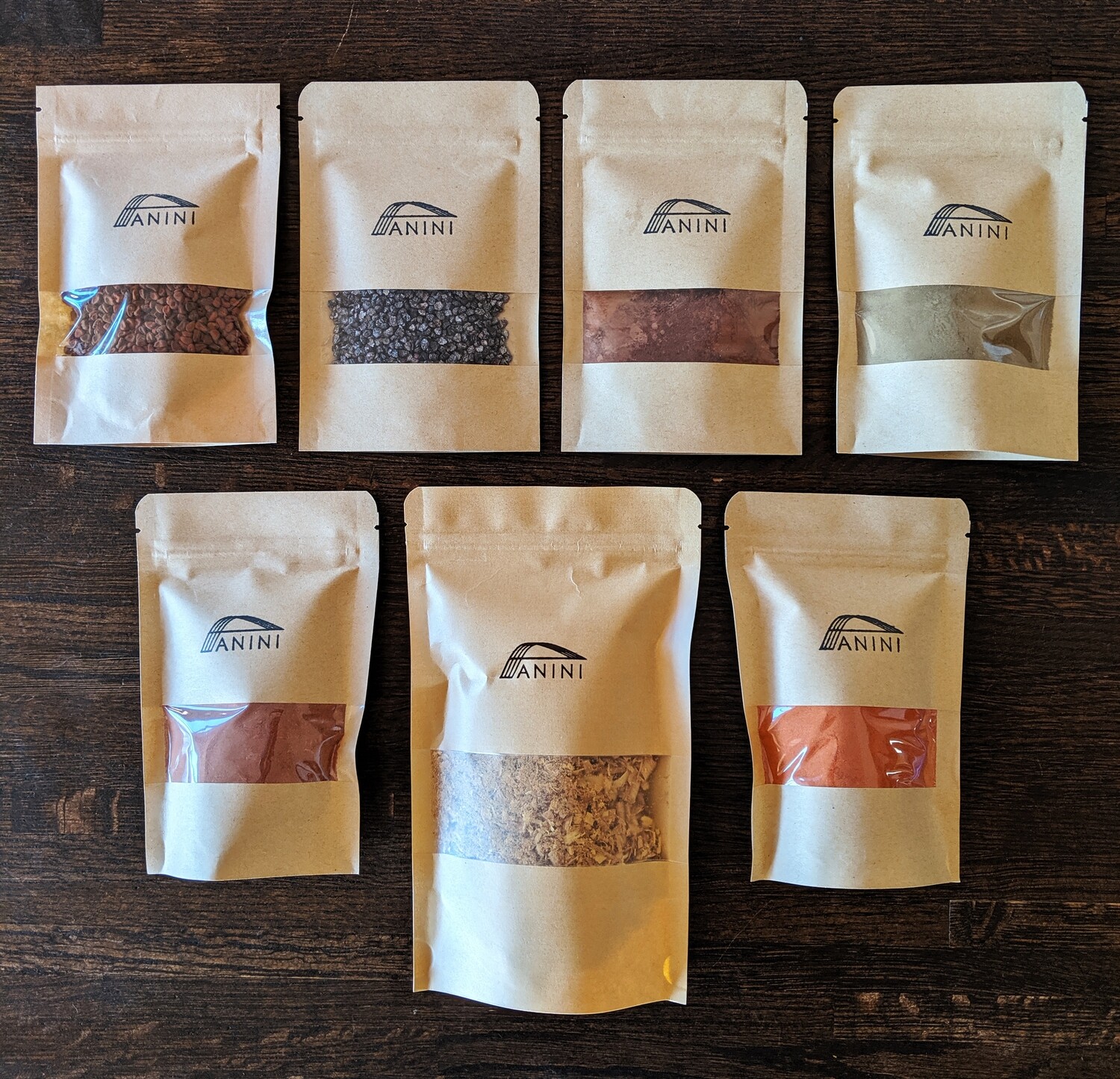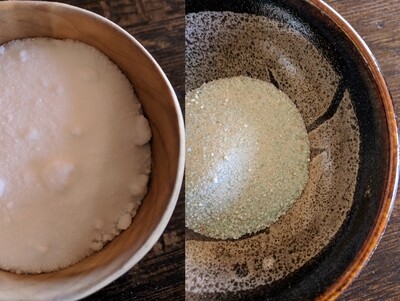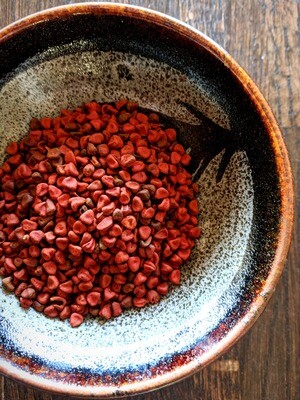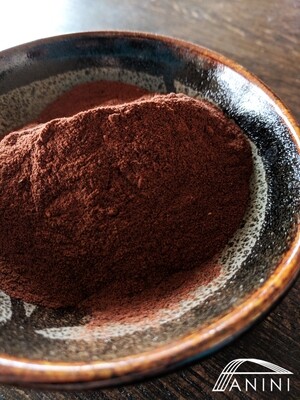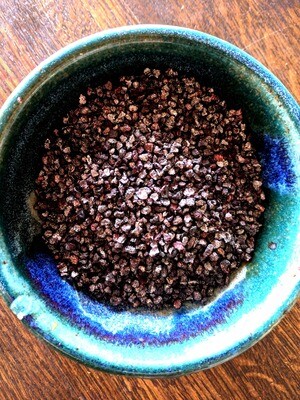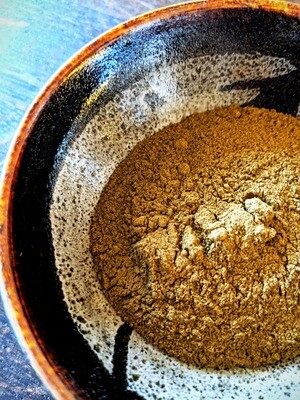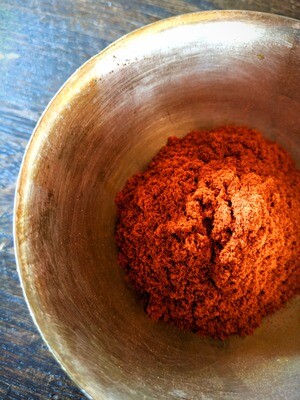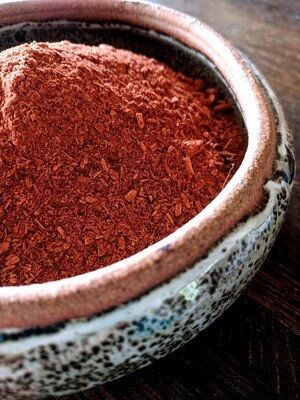BULK SET OF 7 NATURAL DYES
OPTIONS TO ADD:
ALUM &/OR IRON MORDANTS
NATURAL DYES INCLUDED:
50 grams ANNATTO SEED
20 grams COCHINEAL *Fair Trade, Organic
20 grams CUTCH
50 grams HENNA
50 grams MADDER ROOT *Organic
40 grams OSAGE
40 grams of RED SANDALWOOD
MORDANTS (OPTIONAL):
150 grams ALUM
25 grams IRON
Welcome to the Amazing World of Natural Dye!
If you want to dye natural fiber items with this amazingly rich, luscious, magical color that keeps producing color -- you're in the right place!
Basic history, color ranges and quantities for measurement of dye to the weight of fiber are listed below.
50 grams ANNATTO SEED in Whole Form
Annatto is a seed from the Achiote Tree. It has been used to dye textiles for many thousands of years. It's also commonly found in many foods that are enhanced by its natural yellow, orange coloring. It has a deliciously sweet, natural fragrance.
Annatto dyes in cheerful, gorgeous shades of light to golden yellows, peachy-yellow-oranges and bolder oranges.
Annatto will go a long way. 50 grams will dye double its weight in fabric/fiber. The dye will continue to give color in gorgeous lighter shades at a lower ratio, depending on what shade of color you are looking for (dark, medium, lighter tones). To achieve a rich, dark color, use approximately .5 : 1 (weight of Annatto Seeds : weight of Dry Fabric).
20 grams COCHINEAL (insect) in Whole Form * Fair Trade, Organic
Cochineal is a natural dye harvested from the body of a tiny insect that lives on cacti. Cochineal has been used to dye textiles for thousands of years, and more recently (in the last few centuries) it's been used to make those bright, radiant pinks and reds in make-up, and to color foods.
Cochineal dyes in gorgeously rich shades of pinks, magentas, reds and purples.
Cochineal is a very potent dyestuff. 20 grams will dye a varied quantity of items, dependant on the weight of those items and what shade of color you are looking for (dark, medium, lighter tones). To achieve a rich, dark color, use approximately 5-10% the weight of the dry fabric.
20 grams CUTCH in Fine Powder Form
Cutch is a natural dye from the heartwood of the Cutch Tree. Cutch has been used to dye textiles for many thousands of years across the Middle East and into Asia. It has a beautiful, fragrant scent.
Cutch dyes in gorgeous shades of golden caramel, taupes, tans, fawns, red-browns, and browns to dark umbers.
A little Cutch colors a lot. 20 grams will dye a varied quantity of items, dependant on the weight of those items and what shade of color you are looking for (dark, medium, lighter tones). To achieve a rich, dark color, use approximately 1:5 (weight of Cutch : weight of Dry Fabric).
50 grams HENNA in Fine Powder Form
Henna is a natural dye from the leaves of the Henna plant (Lawsonia inermis), a flowering shrub. Henna has been used as natural body dye for thousands of years in India, Africa and the Middle East in a practice called Mehndi. Painted on in often complex designs and patterns, Henna has been used for over 5,000 years to color fingernails, fingers, skin and hair. Additionally, Henna is an herb and has been used to help with a wide variety of complaints.
Henna dyes in a range of earthy fawns to golden and even red-orange hues.
Henna can be used at .75:1 ratio, up to 1:1 weight for the richest color. This means that 50 grams will dye approximately 50 grams (dry weight) of fiber/fabric. It will continue to dye in lighter shades till the dye has been used up. Use less for a lighter hue.
NOTE: This is not a cosmetic grade Henna. This is a textile and fiber grade dye.
50 grams MADDER ROOT in Small Wood Chip Form
Madder is a natural dye from the root of the perennial plant of the same name. Madder Root has been used to dye textiles for thousands of years and dyes in beautiful shades of earthy reds. It was most famously used to dye the British Red of the Redcoats, but can be found coloring ancient textiles around the world.
Madder dyes in a range of earthy, rich shades of reds, oranges and corals.
Madder Root can be used at .5 : 1 ratio, up to 1 : 1 weight for the richest color. This means that 50 grams will dye approximately 50 grams (dry weight) of fiber/fabric. It will continue to dye in lighter shades till the dye has been used up. Use less for a lighter hue of red.
40 grams OSAGE in Small Wood Peeling Form
Osage is a natural dye from the heartwood of the Osage Tree, a native North American plant grown in the Southern States of the United States of America. Osage has been used in North America for many years, and yet its history is less researched than many traditional natural dyes worldwide. Osage is a strong tree, its wood being used for countless centuries to craft the best bows. It later served as a critical wood in forging the basic necessities of early settler life.
Osage dyes in a range of bright to lighter golden yellow, rich shades.
Osage can be used at .75:1 ratio to 1:1 weight for the richest color. This means that 40 grams will dye approximately 40 grams (dry weight) of fiber/fabric. It will continue to dye in lighter shades till the dye has been used up. Use less for a lighter hue of gold or yellow.
40 grams of RED SANDALWOOD in Fine Powder Form
Red Sandalwood is from a tree called the African Coralwood or African Padauk (Pterocarpus soyauxii) grown in Central Africa. (NOTE: It is NOT traditional Sandalwood (of the genus Santalum), as it is a threatened species indigenous to India and it is illegal to harvest and sell elsewhere.) Red Sandalwood is a Natural Dye sourced from the African Coralwood or Padauk Tree (Pterocarpus soyauxii). It is well-known and loved as a natural dye and stain of woods and has a 4,000+ year history on the continent. It has traditionally been used as a body dye for religious purposes. It has been valued for making African drums for its specific tonal resonance.
Red Sandalwood dyes in a range of earthy, rich rusty shades of reds, pinks, peaches and corals.
Red Sandalwood can be used at .5:1 ratio with the richest and darkest colors presenting when using a 1:1 weight ratio. This means that 40 grams will dye approximately 40 grams (dry weight) of fiber/fabric. It will continue to dye in lighter shades till the dye has been used up. Use less for a lighter hue. Additionally, for the best color, pre-soak the dye in alcohol before dyeing.
ABOUT MORDANTS
ALUM and IRON are used to mordant fibers and fabrics before applying Natural Dye. Mordant gives Natural Dyes a surface to grip permanently.
Without mordant, most Natural Dyes will either immediately rinse out or quickly fade, or both.
150 grams ALUM in Fine Powder Form
* Also known as Potassium Aluminum Sulfate
Alum Mordant helps Natural Dyes achieve their brightest, strongest potentials when dyed over. It is a safe metallic salt and perfect for home use.
It's good for use on Protein and Cellulose fibers/fabrics. Alum is used at 15-20%. Divide the total weight of dry fiber/fabric by 15-20% to determine your needs.
25 grams IRON in Fine Powder Form
* Also known as Ferrous Sulfate
Iron is used to mordant fibers and fabrics either before applying Natural Dye or as a Post-Mordant Color Shifter.
Iron is used at 2-4%. Divide the total weight of dry fiber/fabric by 2-4% to determine your needs.
Iron Mordant helps Natural Dyes achieve deep, dark, moody hues. It is a safe metallic salt and perfect for home use.
It's good for use on Protein and Cellulose fibers/fabrics.
As a Pre-Mordant, Iron gives Natural Dyes a surface to grip permanently while shifting colors to a dark, moody palette.
As a Post-Mordant, Iron allows a dyer to shift many dyes to a different spectrum of color.
** Be sure to not overdue Iron on silks and protein fibers.
BASICS
* What can be dyed? Natural Dyes only adhere long-term to Natural Fibers. Natural Fibers include, but are not limited to silk, linen, cotton, flax, hemp, ramie, rayon, bamboo, wool, mohair, alpaca, cashmere, etc.
* COLOR NOTE: ANINI Designs is not responsible for the color you reach through this varied and multi-faceted process. Your color results will be determined by how you approach the Natural Dye process (e.g. as in, what minerals are present in the water you use, what temperatures you heat to, which mordant you use, what type of metal pot you choose to mordant and dye in, what fiber type you're dyeing, etc.).
* ANINI MISSION: I am committed to creating pieces that speak in conversation with, for, and in support of our amazing environment.
By purchasing from ANINI Designs you are supporting an independent, work-from-home fiber artisan who is weaving her peace, love, joy and the future into each textile.
* HEALTH NOTE: Natural Dyes and Mordants may cause irritation to skin. Each person has their own sensitivities. Please use with care and take necessary precautions (e.g. use gloves and face mask) while handling, pouring, transferring, cooking, etc.
* PREP WARNING: Mordant and Natural Dye Pots must only be used with dye processes. Do not use a kitchen-cooking pot that you plan on using again with food.
*
ECO-FRIENDLY PACKAGING: All kits are shipped in a recyclable cardboard box.
* INTERNATIONAL SHIPPING: Buyer is wholly responsible for import/export rules to their country. ANINI Designs is not responsible for knowing all international shipping law. This means, your country may not allow metallic salts and may be seized by customs. There will be no refunds if this should take place.
* PROCESSING TIME: This item is ready to ship upon order. Item will be posted within 3-5 standard business days (not including holidays). If you have specific time constraints, please do reach out before purchase. Thank you!
* GIFT ORDERS: Please add a NOTE upon purchase if you'd like a hand-written note included in your package.
* NO RETURN/REFUNDS: Because of the nature of Natural Dyes and Mordants, ANINI Designs does not accept exchanges or returns on any/all Natural Dyes, Mordants and Natural Dye Kits.
* VISIBILITY: Colors may vary slightly due to computer settings
